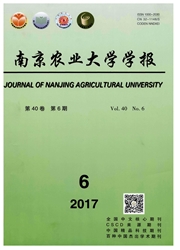

 中文摘要:
中文摘要:
依据温室温光条件与甜瓜单株叶面积的关系,建立了甜瓜叶面积指数(LAI)模型,结合已有的光合作用驱动的作物生长模型,建立了适合我国种植技术的甜瓜光合作用与干物质积累动态模型。利用不同基质、品种和播期的试验资料对模型进行了检验。结果表明,本模型较用比叶面积和叶干重的SLA法及用积温与叶面积的函数的GDD法更能准确地模拟温室甜瓜的LAI和植株总干重。LAI的模拟值与实测值之间的决定系数(R^2)和回归估计标准误(RMSE)分别为0.867和0.404,植株总干重的模拟值与实测值之间的序和RMSE分别为0.887和645kg·hm^-2。用本模型模拟LAI的精度分别比SLA法和GDD法提高78%和40%;模拟植株总干重的精度分别比SLA法和GDD法提高57%和36%。本模型不仅改善了甜瓜叶面积和干物质生产的模拟精度,而且提高了模型的实用性。
 英文摘要:
英文摘要:
A greenhouse muskmelon leaf area simulation model was developed based on the relationship between leaf area per plant and the product of thermal effectiveness and photosynthetically active radiation (TEP). Then a process-based photosynthesis and dry matter production model of greenhouse muskmelon was developed by integrating the leaf area index (LAI) model into the exist- ing photosynthesis-driven crop growth model. Experiments with different sowing dates, varieties and substrates were carried out in Shanghai and Nanjing to collect data to calibrate and validate the model. The results show that the model can predict leaf area and total dry weight of greenhouse muskmelon more accurately than the traditional specific leaf area (SLA) and growing degree days (GDD) based models. The determination coefficient (R2) and the root mean squared error (RMSE) between the observed and the predicted LAI based on the 1 : 1 line are 0. 867 and 0. 404, respectively. The R^2 and RMSE between the predicted and the measured total biomass based on the 1 : 1 line are 0. 887 and 645 kg · hm^-2, respectively. Compared to the SLA and GDD based models, the prediction accuracy of the TEP based model is 78% and 40% higher, respectively, for LAI, and 57% and 36% higher, respectively, for total biomass. The model developed in this study improves not only the prediction accuracy of leaf area and dry matter production, but also the user-friendliness of the model.
 同期刊论文项目
同期刊论文项目
 同项目期刊论文
同项目期刊论文
 Simulation of Greenhouse Management under Subtropical Climate Conditions, Part I: Model validation a
Simulation of Greenhouse Management under Subtropical Climate Conditions, Part I: Model validation a 期刊信息
期刊信息
